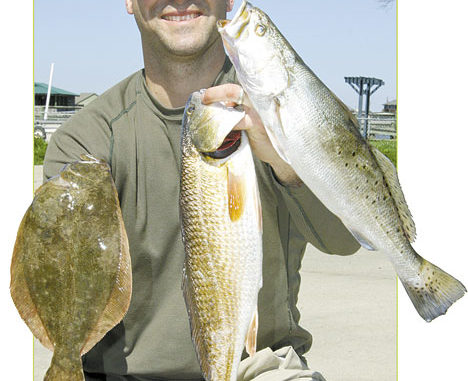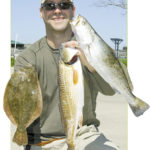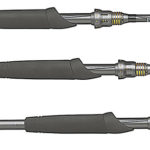
Wading has gotten extremely popular on Calcasieu Lake, but fishing out of a kayak is much more effective.
I wasn’t too sure what to make of Greg Sonnier’s question when I first met him at Hebert’s Marina on the eastern shore of Calcasieu Lake.
“You a runner?” he asked.
Uh oh. This didn’t sound very good at all. I informed Sonnier that I hadn’t run since Uncle Sam stopped forcing me to some 20 years ago.
The kayaker from Lafayette just looked like a runner as he darted around his SUV to untie the two kayaks secured to the top.
I thought about handing him a cup of water, but all I could do was stand there and try to get a little more breathing room by tugging at my belt into which I had just poked a new hole.
Getting settled into my kayak wasn’t all that big of a deal. At least I could sit down, and I’ve been in enough canoes, jonboats and pirogues to know not to make any sudden movements in a small craft like the one in which I found myself.
Actually, my borrowed Hobie Mirage Revolution felt stable enough to put up with some sudden movements even though I wasn’t going to be the one making them. I felt like I was enveloped in the cockpit of a plane with all my gear no farther than arm’s reach away.
Sonnier directed me to head out to the end of a rocky point just beyond the ramp where he would meet up with me as soon as he got his Hobie Outback Mirage launched.
I made it out there after bouncing off a revetment wall, the trailer of a boat that was launching beside us and a couple of the rocks where I was supposed to wait.
Little did I know at the time that before we would reach the spot Sonnier had chosen for us to fish I would have logged enough float time to be considered a certified recreational kayak pilot.
From Hebert’s, Sonnier and I pointed our kayaks north toward a well-known community hole known as the Blue Camp. Our mile-and-a-half trip was made a little easier thanks to Hobie’s Mirage drive system that uses foot-powered fins under the kayak, but that only meant my legs burned rather than my arms.
Along the way, Sonnier trolled a soft plastic behind his boat.
“It’s a habit more than anything,” he explained while encouraging me to keep my legs moving to keep up with him. “I throw a bait out when I get in the water and try to pay attention to what it’s grabbing along the way.
“There could be reefs out there that people don’t fish. When I find something, I make a note of it on the GPS in my phone, and I come back to that spot. These are reefs that a guy in a big boat might not find because they’re moving too fast, and they never stop to fish that spot.”
Sonnier didn’t find any reefs or fish on our excursion to the Blue Camp area. However, our paddle gave him plenty of time to explain exactly what it is that attracts him to kayaks rather than bay boats.
“Man, I was tired of dealing with a boat,” he began. “The maintenance … and we started getting to the age where we started having kids. It’s just a whole lot harder to get away. It’s easier to get away when a kayak is just sitting there in the garage. Throw it on your car or in your truck bed, and you’re gone.”
And getting in a kayak isn’t nearly as expensive as getting into a bay boat. Sonnier says used kayaks can often be found for $400 to $600 to get a decent rig. He explained that kayaks are just like boats, and that makes them one of the first things to go when people look to start cleaning out their garages.
“I would spend $700 to $1,000 on a new one if it was me,” Sonnier continued. “Just knowing what I know.
“I made the mistake of buying the brand-new $300 kayak and being real unhappy with it and getting rid of it the next week.”
My kayak crash course came to an end when we finally arrived at our spot. Rather than continue to talk about why he likes to fish out of a kayak, Sonnier put his kayak to good use and started fan-casting a topwater bait near the marshy bank of the large cove.
I started by throwing a Bomber Badonk-A-Donk SS suspending bait because of some past experiences fishing this same cove standing on the deck of a bay boat. Neither of our baits got any action, but we figured it was more of the lack of baitfish rather than the trout just not liking our offerings.
A few jumping mullet and some flickering baitfish about 300 yards away got my attention, so I put my newly acquired piloting skills to work and ventured far away from my security zone out to the only action anywhere around.
By the time I had reached the baitfish activity, a boat full of wade fishermen had parked and disembarked. They scattered out in a row between me and the bank, which put them in the front row for the show that was about to commence.
Their only problem was that they couldn’t wade as far as they needed to become more than spectators. That’s when Sonnier and I discussed the benefits of a kayak as being a combination of a stealthy approach in shallow water and a stable platform for deeper water.
Within short order, a nice speckled trout had inhaled my glow/chartreuse Texas Tackle Factory Hackberry Hustler threaded onto a 1/4-ounce Marsh Works Shorty jig head that I was bouncing on the bottom.
Sonnier pedaled his way out to where I was so he could put our first fish in his soft-sided ice chest. By the time he could slide it in the bag, I was already yanking on another one. Even though our second fish got off, Sonnier decided to drop the anchor on his kayak so we wouldn’t inadvertently get blown off our little hotspot.
Claiming to not being so dumb as to continue throwing his topwater after two quick fish on the soft plastic, Sonnier switched to a glow/chartreuse Norton Sand Eel rigged on a 1/4-ounce jighead. His decision was almost immediately proven the correct one, and he added our second trout to the bag in short order.
“A lot of the tournaments are slam,” Sonnier said during a lull in the action. “They’re multi-fish stringer oriented. You have to go out and catch a red, a trout and a flounder.
“It’s hard enough to be in a kayak; I don’t know why we do this to ourselves.”
Almost as if on cue, Sonnier’s rod doubled over under the weight of a fish that was pulling just a little bit differently than the trout he had already landed. As the flounder cut the surface, Sonnier realized he was two-thirds of the way into a kayak slam for the day.
Our little offshore spot eventually dried up, so Sonnier suggested we move back in close to the bank to see if we could go ahead and complete the slam. The wind was starting to blow a little stiffer straight out of the south, and my concern about being in such a small craft in a strong wind was alleviated somewhat by being back closer to solid ground.
I could see Sonnier’s rod jump as I floated past him.
“Yep, there he is,” he grunted as he began to battle the redfish. It wasn’t big enough to give him the proverbial Cajun sleigh ride, but it did complete his slam just as soon as he netted the fish and pulled it into his kayak.
With the slam secure and the winds whipping, we decided it was time to pedal our way back to Hebert’s. Surprisingly to me, our kayaks cut into the waves with minimal effort, and working our way back into the wind was barely any more strenuous than our pedal out earlier in the morning.
As I helped Sonnier load his kayaks back onto the rack atop his SUV, he began to relate kayak fishing to walking a golf course.
“When you ride a cart,” he observed, “I find you pay less attention to what’s going on around you. Your whole environment — everything. I find you pay more attention when you walk a golf course, and the same holds true when you’re kayak fishing.
“As I’m getting out there, I try to pay attention to what’s going on — the water clarity, wind, bait, tides. I just find I don’t pay as much attention to those things when going 40 to 50 mph in a bay boat. It’s a lot easier to see what’s going on at water level when you’re at the same level as the water.”
Walking a golf course? Pedaling a kayak? Sounds to me like Sonnier is a big proponent of manual labor. And the way the world is going today, self reliance seems to be the best way to get ahead when everybody else is falling behind.

